Oracle建表命令
Oracle基本建表语句
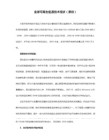
commit;
insert into stu_couse values(stu_couse_seq.nextval,1,1);
insert into stu_couse values(stu_couse_seq.nextval,1,3);
)
alter table course to couse;
create table stu_couse(
stu_couse_id number(9) primary key,
stu_id number(9) not null,
couse_id number(9) not null
)
查询表:
select * from classes;
删除表:
drop table students;
修改表的名称:
rename alist_table_copy to alist_table;
显示表结构:
describe test
--------------------------------------------------------
zc_id number(9) not null primary key,
stu_id number(9) not null,
zhucetime date default sysdate
)
create table feiyong (
fy_id number(9) not null primary key,
对字段的操作
oracle批量查询建表语句

oracle批量查询建表语句Oracle数据库是一种常见的关系型数据库系统,常常被用于存储和处理大量数据。
在进行数据分析和数据挖掘时,我们常常需要从Oracle中查询大量的数据,并在本地进行分析。
这时,我们就需要将Oracle中的数据导出到本地进行处理。
但是,如果需要导出的数据非常多,手动创建大量的表格显然是不现实的,这时我们就需要使用Oracle批量查询建表语句,自动化地将数据导出到对应的表格中。
一、准备工作在进行批量查询建表语句之前,我们需要先创建一个包含需要导出数据的查询语句的文件。
这个文件可以是一个普通的txt文件,每一行表示一个查询语句。
比如,我们可以将以下查询语句保存到一个名为“query.txt”的文件中:select * from employees where department_id = 10;select * from employees where department_id = 20;select * from employees where department_id = 30;二、使用SQL*Plus创建表格SQL*Plus是Oracle提供的一个命令行工具,可以方便地从Oracle数据库中查询数据。
在本地电脑上安装了Oracle的客户端之后,我们就可以使用SQL*Plus来进行批量查询建表语句了。
1. 开启SQL*Plus在Windows系统下,我们可以通过Win+R快捷键打开“运行”窗口,然后输入“cmd”命令,进入命令行界面。
接着,输入“sqlplus username/password@database”连接到Oracle数据库。
其中,username表示Oracle数据库的用户名,password表示密码,database表示连接的数据库名。
2. 执行查询语句在SQL*Plus中执行查询语句的方式非常简单。
我们只需要输入查询语句,按下回车键,就可以得到查询结果。
Oracle创建表语句(Createtable)语法详解及示例

Oracle创建表语句(Createtable)语法详解及⽰例创建表(Create table)语法详解1. ORACLE常⽤的字段类型ORACLE常⽤的字段类型有VARCHAR2 (size) 可变长度的字符串, 必须规定长度CHAR(size) 固定长度的字符串, 不规定长度默认值为1NUMBER(p,s) 数字型p是位数总长度, s是⼩数的长度, 可存负数最长38位. 不够位时会四舍五⼊.DATE ⽇期和时间类型LOB 超长字符, 最⼤可达4GCLOB 超长⽂本字符串BLOB 超长⼆进制字符串BFILE 超长⼆进制字符串, 保存在外的⽂件⾥是只读的.数字字段类型位数及其四舍五⼊的结果原始数值1234567.89数字字段类型位数存储的值Number 1234567.89Number(8) 12345678Number(6) 错Number(9,1) 1234567.9Number(9,3) 错Number(7,2) 错Number(5,-2) 1234600Number(5,-4) 1230000Number(*,1) 1234567.92. 创建表时给字段加默认值和约束条件创建表时可以给字段加上默认值例如 : ⽇期字段 DEFAULT SYSDATE这样每次插⼊和修改时, 不⽤程序操作这个字段都能得到动作的时间创建表时可以给字段加上约束条件例如: ⾮空 NOT NULL不允许重复 UNIQUE关键字 PRIMARY KEY按条件检查 CHECK (条件)外键 REFERENCES 表名(字段名)3. 创建表的例⼦CREATE TABLE DEPT(EPTNO NUMBER(2) CONSTRAINT PK_DEPT PRIMARY KEY,DNAME VARCHAR2(14),LOC VARCHAR2(13)) ;CREATE TABLE region(ID number(2) NOT NULL PRIMARY KEY,postcode number(6) default '0' NOT NULL,areaname varchar2(30) default ' ' NOT NULL);4. 创建表时的命名规则和注意事项1)表名和字段名的命名规则:必须以字母开头,可以含符号A-Z,a-z,0-9,_,$,#2)⼤⼩写不区分3)不⽤SQL⾥的保留字, ⼀定要⽤时可⽤双引号把字符串括起来.4)⽤和实体或属性相关的英⽂符号长度有⼀定的限制注意事项:1)建表时可以⽤中⽂的字段名, 但最好还是⽤英⽂的字段名2)创建表时要把较⼩的不为空的字段放在前⾯, 可能为空的字段放在后⾯3)建表时如果有唯⼀关键字或者唯⼀的约束条件,建表时⾃动建了索引4)⼀个表的最多字段个数也是有限制的,254个.5. 约束名的命名规则和语法约束名的命名规则约束名如果在建表的时候没有指明,系统命名规则是SYS_Cn(n是数字)约束名字符串的命名规则同于表和字段名的命名规则6. 使⽤约束时的注意事项约束⾥不能⽤系统函数,如SYSDATE和别的表的字段⽐较可以⽤本表内字段的⽐较想在事务处理后, 做约束的检查SQL> alter session set constraints deferred.7. 由实体关系图到创建表的例⼦ s_dept前提条件:已有region表且含唯⼀关键字的字段idSQL> CREATE TABLE s_dept(id NUMBER(7)CONSTRAINT s_dept_id_pk PRIMARY KEY,name VARCHAR2(25)CONSTRAINT s_dept_name_nn NOT NULL,region_id NUMBER(7)CONSTRAINT s_dept_region_id_fk REFERENCES region (id),CONSTRAINT s_dept_name_region_id_uk UNIQUE(name, region_id));8. 较复杂的创建表例⼦SQL> CREATE TABLE s_emp(id NUMBER(7)CONSTRAINT s_emp_id_pk PRIMARY KEY,last_name VARCHAR2(25)CONSTRAINT s_emp_last_name_nn NOT NULL,first_name VARCHAR2(25),userid VARCHAR2(8)CONSTRAINT s_emp_userid_nn NOT NULLCONSTRAINT s_emp_userid_uk UNIQUE,start_date DATE DEFAULT SYSDATE,comments VARCHAR2(25),manager_id NUMBER(7),title VARCHAR2(25),dept_id NUMBER(7)CONSTRAINT s_emp_dept_id_fk REFERENCES s_dept(id),salary NUMBER(11,2),commission_pct NUMBER(4,2)CONSTRAINT s_emp_commission_pct_ck CHECK(commission_pct IN(10,12.5,15,17.5,20)));8. 通过⼦查询建表通过⼦查询建表的例⼦SQL>CREATE TABLE emp_41 AS SELECT id, last_name, userid, start_dateFROM s_emp WHERE dept_id = 41;SQL> CREATE TABLE A as select * from B where 1=2;只要表的结构.10. ⽤⼦查询建表的注意事项1)可以关连多个表及⽤集合函数⽣成新表,注意选择出来的字段必须有合法的字段名称,且不能重复。
抓取oracle建表语句及获取建表ddl语句

抓取oracle建表语句及获取建表ddl语句抓取oracle建表语句及获取建表ddl语句1.抓取代码如下: 1.1.产⽣表的语法资料DECLARE-- v_notPartTable VARCHAR2(1000):= '&2';--v_sql CLOB;v_partType VARCHAR2(20);v_partColumn VARCHAR2(50);v_subPartType VARCHAR2(50);v_subPartSql VARCHAR2(4000);v_seq NUMBER := 10;BEGINFOR v_cur in (SELECT table_name,partitioned,t.TABLESPACE_NAME,t.PCT_FREE, t.LOGGING, t.CACHE FROM user_tables twhere table_name = 'TEST1') LOOPv_seq := v_seq + 1;INSERT INTO tmp_tabsql(seq,table_name,table_sql) VALUES(v_seq, v_cur.table_name, 'CREATE TABLE ' || v_cur.table_name || '(' ); --columnsFOR v_column IN (SELECT CASE WHEN REGEXP_LIKE (COLUMN_NAME,'^\d+$') THEN '"'||COLUMN_NAME||'"' ELSE COLUMN_NAME END COLUMN_NAME, DATA_TYPE,DATA_LENGTH, DATA_PRECISION,DATA_SCALE,COLUMN_IDFROM user_tab_columnsWHERE table_name = v_cur.table_nameORDER BY column_id ASC) LOOPv_seq := v_seq + 1;INSERT INTO tmp_tabsql(seq, table_name, table_sql) VALUES(v_seq, v_cur.table_name,CASE WHEN v_column.column_id <> 1 THEN ' ,' END|| v_column.column_name || ' ' || v_column.data_type|| CASE v_column.data_type WHEN 'TIMESTAMP(6)' THEN '' WHEN 'DATE' THEN ''WHEN 'CLOB' THEN '' WHEN 'BLOB' THEN ''WHEN 'NUMBER' THENCASEWHEN v_column.data_scale is NOT NULL AND v_column.data_precision IS NOT NULL THEN'('||v_column.data_precision||','||v_column.data_scale||')'WHEN v_column.data_precision IS NOT NULL THEN '(' || v_column.data_precision|| ')'ENDELSECASE WHEN v_column.data_length IS NOT NULL THEN '(' || v_column.data_length || ')' ENDEND);END LOOP;v_seq := v_seq + 1;INSERT INTO tmp_tabsql(seq, table_name, table_sql) VALUES(v_seq, v_cur.table_name, ')');IF v_cur.partitioned = 'YES' THENSELECT t.partitioning_type, t.subpartitioning_type , tk.column_nameINTO v_partType, v_subPartType, v_partColumnFROM User_Part_Tables t, User_Part_Key_Columns tkwhere t.table_name = AND t.table_name = v_cur.table_name;v_seq := v_seq + 1;INSERT INTO tmp_tabsql(seq, table_name, table_sql) VALUES(v_seq, v_cur.table_name,' pctfree 0 nologging partition by ' || v_partType ||'('||v_partColumn||')' );-- subpartitionv_subPartSql := '';IF v_subPartType <> 'NONE' THENSELECT t.column_name INTO v_partColumn FROM user_subpart_key_columns tWHERE = v_cur.table_namev_subPartSql := 'subpartition by '|| v_subPartType ||'('|| v_partColumn ||') subpartition template (' ||CHR(10);FOR v_tmp in (SELECT t.subpartition_name, t.high_bound, t.subpartition_positionFROM User_Subpartition_Templates tWHERE TABLE_NAME = v_cur.table_nameORDER BY t.subpartition_position ASC) LOOPv_subPartSql := v_subPartSql || CASE WHEN v_tmp.subpartition_position > 1 THEN CHR(10) ||' ,' END|| 'subpartition '|| v_tmp.subpartition_name || ' values (' || v_tmp.high_bound || ')';END LOOP;v_subPartSql := v_subPartSql || CHR(10) || ')' ||CHR(10);END IF;v_seq := v_seq + 1;INSERT INTO tmp_tabsql(seq, table_name, table_sql) VALUES(v_seq, v_cur.table_name,v_subPartSql || '(partition P2011010100 values less than (to_date(''2011-01-01'',''yyyy-mm-dd'')));');ELSEv_seq := v_seq + 1;INSERT INTO tmp_tabsql(seq,table_name,table_sql) VALUES(v_seq, v_cur.table_name,' TABLESPACE ' || v_cur.tablespace_name|| ' PCTFREE ' || v_cur.pct_free|| CASE TRIM(v_cur.logging) WHEN 'NO' THEN ' NOLOGGING' END|| CASE trim(v_cur.cache) WHEN 'Y' THEN ' CACHE' END||';');END IF;COMMIT;END LOOP;END;/1.2.输出⽂本资料spool &1select table_sql from (SELECT 'set echo off;' table_sql,0 seq from dualUNION ALLSELECT 'set feedback off;', 1 seq FROM dualunion ALLSELECT table_sql,seq FROM tmp_tabsqlUNION ALLSELECT 'exit;',9999999999 seq from dual) order by seq asc;spool OFF;drop TABLE tmp_tabsql PURGE;EXIT;2 获取建表ddl语句2.1.获取ddl ##('TABLE','表名','⽤户名')SELECT DBMS_METADATA.GET_DDL('TABLE','ODRM','S6MISM') FROM DUAL;2.2. 得到⼀个⽤户下的所有表,索引,存储过程的ddlSELECT DBMS_METADATA.GET_DDL(U.OBJECT_TYPE, u.object_name) FROM USER_OBJECTS u where U.OBJECT_TYPE IN ('TABLE','INDEX','PROCEDURE');2.3.得到所有表空间的ddl语句SELECT DBMS_METADATA.GET_DDL('TABLESPACE', TS.tablespace_name) FROM DBA_TABLESPACES TS;2.4.得到所有创建⽤户的ddlSELECT DBMS_METADATA.GET_DDL('USER',ERNAME) FROM DBA_USERS U;。
oracle建表的时候同时创建主键,外键,注释,约束,索引
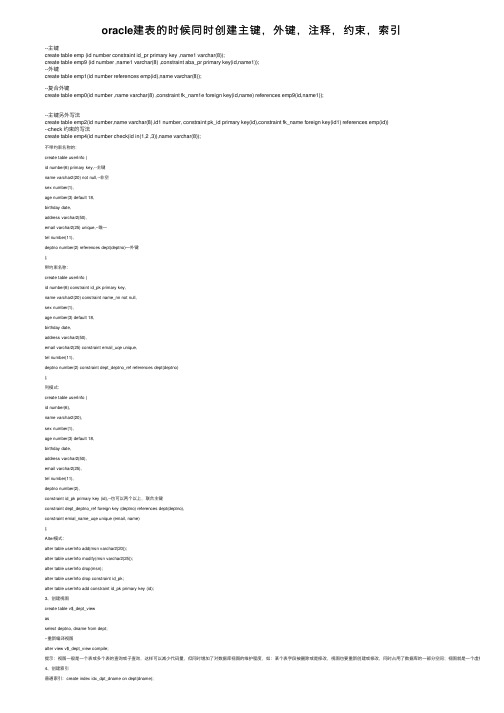
oracle建表的时候同时创建主键,外键,注释,约束,索引--主键create table emp (id number constraint id_pr primary key ,name1 varchar(8));create table emp9 (id number ,name1 varchar(8) ,constraint aba_pr primary key(id,name1));--外键create table emp1(id number references emp(id),name varchar(8));--复合外键create table emp0(id number ,name varchar(8) ,constraint fk_nam1e foreign key(id,name) references emp9(id,name1));--主键另外写法create table emp2(id number,name varchar(8),id1 number, constraint pk_id primary key(id),constraint fk_name foreign key(id1) references emp(id))--check 约束的写法create table emp4(id number check(id in(1,2 ,3)),name varchar(8));不带约束名称的:create table userInfo (id number(6) primary key,--主键name varchar2(20) not null,--⾮空sex number(1),age number(3) default 18,birthday date,address varchar2(50),email varchar2(25) unique,--唯⼀tel number(11),deptno number(2) references dept(deptno)—外键);带约束名称:create table userInfo (id number(6) constraint id_pk primary key,name varchar2(20) constraint name_nn not null,sex number(1),age number(3) default 18,birthday date,address varchar2(50),email varchar2(25) constraint email_uqe unique,tel number(11),deptno number(2) constraint dept_deptno_ref references dept(deptno));列模式:create table userInfo (id number(6),name varchar2(20),sex number(1),age number(3) default 18,birthday date,address varchar2(50),email varchar2(25),tel number(11),deptno number(2),constraint id_pk primary key (id),--也可以两个以上,联合主键constraint dept_deptno_ref foreign key (deptno) references dept(deptno),constraint emial_name_uqe unique (email, name));Alter模式:alter table userInfo add(msn varchar2(20));alter table userInfo modify(msn varchar2(25));alter table userInfo drop(msn);alter table userInfo drop constraint id_pk;alter table userInfo add constraint id_pk primary key (id);3、创建视图create table v$_dept_viewasselect deptno, dname from dept;--重新编译视图alter view v$_dept_view compile;提⽰:视图⼀般是⼀个表或多个表的查询或⼦查询,这样可以减少代码量,但同时增加了对数据库视图的维护程度,如:某个表字段被删除或是修改,视图也要重新创建或修改,同时占⽤了数据库的⼀部分空间;视图就是⼀个虚拟的表格;4、创建索引普通索引:create index idx_dpt_dname on dept(dname);联合索引:create index idx_dept_dname_deptno on dept(dname, deptno);--唯⼀索引create unique index idx_emp_ename on scott.emp(ename);--反向键索引create index idx_emp_rev_no on scott.emp(empno) reverse;--位图索引create bitmap index idx_emp_name on scott.emp(dname);--索引组织表,⼀定要有主键create table tab (id int primary key,name varchar2(20)) organization index;--索引组织表的insert效率⾮常低--分区表索引create index idx_name on table(col) local/global;--索引分区提⽰:当给表创建主键或唯⼀键约束时,系统也会创建⼀个约束给该字段;同样创建索引也会占⽤数据库空间;索引在访问、查询的时候效率有提⾼,但是在修改表的时候效率就会降低;5、创建序列create sequence seq;select seq.nextval from dual;insert into tab values(sql.nextval, ‘music’);create sequence seqtabstart with 2 –从2开始increment by 3—每次加3nomaxvalue—没有最⼤值minvalue 1—最⼩值1nocycle—不循环nocache;--不缓存--修改序列,不能修改起始值alter sequence seqtabmaxvalue 1000;6、创建同义词同义词,顾名思义就是说别名、或是另⼀个名字。
建表语句oracle转mysql sql语句

建表语句oracle转mysql sql语句全文共四篇示例,供读者参考第一篇示例:在数据库管理系统中,建表语句是非常常见的操作之一。
无论是在Oracle数据库还是在MySQL数据库中,都需要使用建表语句来创建表格结构。
有时候,我们需要将Oracle数据库中的建表语句转换为MySQL数据库中的语句。
下面我们就来看一下如何将Oracle建表语句转换为MySQL建表语句。
在Oracle数据库中,建表语句的语法通常是这样的:```CREATE TABLE table_name(column1 datatype NULL/NOT NULL,column2 datatype NULL/NOT NULL,...PRIMARY KEY (column_name));```table_name是表格名称,column1、column2等是列名,datatype是数据类型,NULL代表列可以为空,NOT NULL代表列不可以为空。
上面是一个简单的建表语句示例。
但是在实际应用中,建表语句可能会更加复杂,包含索引、外键、约束等内容。
在MySQL数据库中,建表语句的语法也类似于Oracle。
但是有一些细微的差异需要注意。
在MySQL中,建表语句的语法通常是这样的:在对建表语句进行转换时,需要注意以下几点:1. 数据类型的转换。
Oracle中的一些数据类型在MySQL中是没有等价的。
在Oracle中常用的NUMBER类型在MySQL中对应的是INT或FLOAT等类型。
2. 约束的转换。
Oracle和MySQL中对约束的定义有一些差异,需要进行相应的调整。
3. 表空间的转换。
Oracle中会使用表空间来管理数据库的数据文件,而MySQL中一般不需要指定表空间。
下面是一个简单的示例,将Oracle建表语句转换为MySQL建表语句:Oracle建表语句:通过以上示例,我们可以看到,在将Oracle建表语句转换为MySQL建表语句时,只需要对数据类型进行相应的调整即可。
oracle查询表的建表语句

oracle查询表的建表语句表1: 学生信息表CREATE TABLE student_info (student_id NUMBER(10) PRIMARY KEY, -- 学生IDstudent_name VARCHAR2(20) NOT NULL, -- 学生姓名gender CHAR(1) CHECK (gender IN ('M', 'F')), -- 性别age NUMBER(2), -- 年龄address VARCHAR2(100), -- 地址phone_number VARCHAR2(20) UNIQUE, -- 手机号码email VARCHAR2(50), -- 邮箱birth_date DATE -- 出生日期);表2: 课程信息表CREATE TABLE course_info (course_id NUMBER(5) PRIMARY KEY, -- 课程IDcourse_name VARCHAR2(50) NOT NULL, -- 课程名称credit NUMBER(1), -- 学分department VARCHAR2(50), -- 开设院系teacher_id NUMBER(10), -- 教师IDCONSTRAINT fk_teacher_id FOREIGN KEY (teacher_id) REFERENCES teacher_info(teacher_id) -- 外键关联教师信息表);表3: 教师信息表CREATE TABLE teacher_info (teacher_id NUMBER(10) PRIMARY KEY, -- 教师IDteacher_name VARCHAR2(20) NOT NULL, -- 教师姓名gender CHAR(1) CHECK (gender IN ('M', 'F')), -- 性别age NUMBER(2), -- 年龄address VARCHAR2(100), -- 地址phone_number VARCHAR2(20) UNIQUE, -- 手机号码email VARCHAR2(50) -- 邮箱);表4: 成绩表CREATE TABLE score_info (student_id NUMBER(10), -- 学生IDcourse_id NUMBER(5), -- 课程IDscore NUMBER(3), -- 成绩CONSTRAINT fk_student_id FOREIGN KEY (student_id) REFERENCES student_info(student_id), -- 外键关联学生信息表CONSTRAINT fk_course_id FOREIGN KEY (course_id)REFERENCES course_info(course_id) -- 外键关联课程信息表);表5: 班级信息表CREATE TABLE class_info (class_id NUMBER(5) PRIMARY KEY, -- 班级IDclass_name VARCHAR2(20) NOT NULL, -- 班级名称department VARCHAR2(50) NOT NULL, -- 所属院系teacher_id NUMBER(10), -- 班主任教师IDCONSTRAINT fk_teacher_id FOREIGN KEY (teacher_id) REFERENCES teacher_info(teacher_id) -- 外键关联教师信息表);表6: 学生选课表CREATE TABLE student_course (student_id NUMBER(10), -- 学生IDcourse_id NUMBER(5), -- 课程IDCONSTRAINT fk_student_id FOREIGN KEY (student_id) REFERENCES student_info(student_id), -- 外键关联学生信息表CONSTRAINT fk_course_id FOREIGN KEY (course_id) REFERENCES course_info(course_id) -- 外键关联课程信息表);表7: 学生考勤表CREATE TABLE student_attendance (student_id NUMBER(10), -- 学生IDcourse_id NUMBER(5), -- 课程IDattendance_date DATE, -- 考勤日期status CHAR(1) CHECK (status IN ('P', 'A')), -- 考勤状态 (P: 出勤, A: 缺勤)CONSTRAINT fk_student_id FOREIGN KEY (student_id) REFERENCES student_info(student_id), -- 外键关联学生信息表CONSTRAINT fk_course_id FOREIGN KEY (course_id) REFERENCES course_info(course_id) -- 外键关联课程信息表);表8: 课程安排表CREATE TABLE course_schedule (course_id NUMBER(5), -- 课程IDweekday VARCHAR2(20), -- 星期几start_time VARCHAR2(10), -- 开始时间end_time VARCHAR2(10), -- 结束时间classroom VARCHAR2(20), -- 上课教室CONSTRAINT fk_course_id FOREIGN KEY (course_id) REFERENCES course_info(course_id) -- 外键关联课程信息表);表9: 教师授课表CREATE TABLE teacher_course (teacher_id NUMBER(10), -- 教师IDcourse_id NUMBER(5), -- 课程IDCONSTRAINT fk_teacher_id FOREIGN KEY (teacher_id) REFERENCES teacher_info(teacher_id), -- 外键关联教师信息表CONSTRAINT fk_course_id FOREIGN KEY (course_id) REFERENCES course_info(course_id) -- 外键关联课程信息表);表10: 学生班级关系表CREATE TABLE student_class (student_id NUMBER(10), -- 学生IDclass_id NUMBER(5), -- 班级IDCONSTRAINT fk_student_id FOREIGN KEY (student_id) REFERENCES student_info(student_id), -- 外键关联学生信息表CONSTRAINT fk_class_id FOREIGN KEY (class_id) REFERENCES class_info(class_id) -- 外键关联班级信息表。
oracle 建表中文注释

oracle 建表中文注释在Oracle数据库中,我们可以通过SQL语句来创建表,并且可以为表的字段添加中文注释。
在创建表时,可以使用如下的SQL语句来添加中文注释:sql.CREATE TABLE 表名 (。
字段1 数据类型注释 '字段1中文注释',。
字段2 数据类型注释 '字段2中文注释',。
...);在上面的SQL语句中,"表名"是要创建的表的名称,"字段1"、"字段2"等是表的字段名称,数据类型是字段的数据类型,中文注释则是用中文描述字段的含义。
在实际使用时,需要将上面的示例中的"表名"、"字段1"、"字段2"、"数据类型"替换为实际的表名、字段名和数据类型,同时将注释内容替换为实际的中文注释。
举例来说,如果我们要创建一个名为"学生信息"的表,其中包括"学号"和"姓名"两个字段,可以使用如下的SQL语句来添加中文注释:sql.CREATE TABLE 学生信息 (。
学号 NUMBER(10) 注释 '学生的学号',。
姓名 VARCHAR2(50) 注释 '学生的姓名'。
);通过以上的SQL语句,我们就成功地在Oracle数据库中创建了一个名为"学生信息"的表,并为表的字段添加了中文注释。
需要注意的是,在Oracle数据库中,使用注释时需要注意数据库的字符集设置,确保数据库能够正确存储和显示中文字符。
另外,在实际开发中,为了便于维护和团队协作,通常会在创建表时为表和字段添加注释,这样可以让其他开发人员更清晰地了解表和字段的含义,提高代码的可读性和可维护性。
oracle数据库建表语句
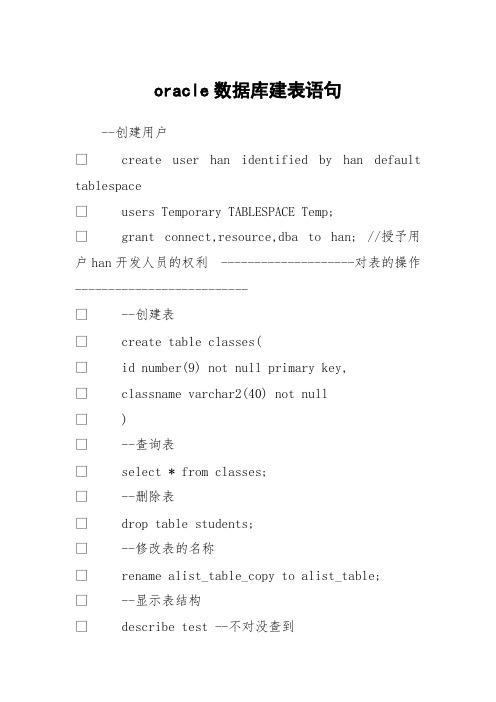
educational practice, is to strengthen the state-owned enterprise party construction, keep the party's advanced nature and purity, consolidating the party's ruling foundation and ruling status of inevitable requirement. The party's advanced nature and the party's ruling status is not a once and for all, immutable. Past advanced does not equal the present advanced, now advanced is not equal to advanced forever. In the past have not equal to now have, now have is not equal to always have. Keep the party's advanced nature and purity, consolidating the party's ruling foundation and ruling position, is the party's Facing the construction of the fundamental problem and the subject of the times. Central enterprises is completed a comprehensive well-off society in an important force, is an important pillar of socialism with Chinese characteristics, is an important basis for the Communist Party of China. To carry out the party's mass line of educational practice, is to further strengthen and improve the party's leadership, play the exemplaryvanguard role of Party members, the people honest and pragmatic value pursuit deeply rooted in the thoughts and actions of all Party members, and keep the party's advanced nature and purity. It is to hold to a party to want to manage the party, strictly, so as to promote the ideological and working style construction of the party building in all respects, Party of the body and the party ranks of self purification, self end At the beginning of the good, self innovation, self - improvement; is to further development of Zhuang country economy and enhance control of state-owned enterprises, influence and vitality to further consolidate the party's ruling foundation, to consolidate the party's ruling status. Third, to carry out the party's mass line of educational practice, is vigorously carry forward the spirit of "Three Gorges", "four winds" in the control group of scientific development outstanding issues to solve the inevitable requirement. The central government decided to the mass line of educational practice is mainly focus on stylebuilding, efforts to solve formalism, bureaucratism, hedonism and extravagant wind "four winds". In the process of long-term construction of the Three Gorges project, the company Always maintain a hard work, truth-seeking and pragmatic, scientific and democratic, solidarity and cooperation of the fine style of work, unity and lead all the Three Gorges builders tenacious struggle, the successful completion of the Three Gorges project construction tasks, to the party and the people on the a qualified answer. Second, conscientiously implement the central spirit, solidly carry out the party's mass line of educational practice central the education practice of guiding ideology, objectives, tasks, basic principles, methods, steps made specific provisions, Party accordingly formulated the < on the in-depth development of the party's mass line of educational practice implementation scheme. Party organizations at all levels must conscientiously implement the spirit of the central government, do a good job of scheme To carry out theexecution, guarantee the educational practice to achieve the worker masses satisfactory effect. Is the guiding ideology of the Corporation of Party's mass line of educational practice, hold high the great banner of socialism with Chinese characteristics, and comprehensively implement the party's eighteen big spirits, to Marxism Leninism, Mao Zedong thought, Deng Xiaoping Theory and the important thought of "Three Represents" and the scientific development concept as a guide, closely around the keep the party's advanced nature and purity that pragmatic and honest people as the main content, the implementation of the provisions of the central eight as a starting point, strengthen the education of the Marxist view of the masses and the party's mass line, with excellent style ningxinjuli for The construction of the Three Gorges project, the development of the Yangtze River, building a world-class large-scale clean energy group to provide a strong guarantee. The theme of group company of educational practice is changing thestyle, ningxinjuli, for the construction of a world-class clean energy group to provide a strong guarantee. Methods: take the lead of the party, from top to bottom. The focus of education is the leading bodies at all levels, leading organs and deputy division level and above cadres. Focusing the outstanding problem is: oppose formalism, bureaucratism, hedonism and extravagant wind. By resolutely opposed "to the four winds", efforts to solve outstanding problems of Party members and cadres in the party spirit party party, affecting the outstanding problems of scientific development to the group company , the outstanding problems of the workers and the masses are strongly. To achieve the goal of requirements are: enhance the ideological quality of the cadres as well as to effectively change the style of work, close party masses relationship, establish image of pragmatic and honest people of. According to the requirements of the central, group company as Wuguan enterprises to participate in the party's mass line of the first batchof educational practice. Among them, group leadership and the departments of the headquarters of educational practice, by the central leadership and sent a steering group. Group owned enterprises and units in late August started, under the leadership of the Party group carry out educational practice, by the party sent a steering group of supervision and inspection. Corporation group and subordinate units of Education Practice time staggered, stubble, in accordance with the requirements of the quality of the progress of the subject of for complete educational practice at the end of November. In accordance with the provisions of the central, education and practice activities divided into three links to. The first link is learning education, listen to their views. The focus of this part is to make a good job in the publicity and ideological education, carry out investigation and study, listen to the opinions of the masses of workers, for revealing and criticism to prepare. Consider to propaganda, focus on learning and education, held a forum,to seek the views of the tasks are relatively heavy, the first link time arranged more than a month, to the end of August. The key learning education is to improve the Ideological awareness, firmly establish the Marxist view of the masses, bearing in mind the wholeheartedly the fundamental purpose of serving the people. To me to learn the spirit of the central document, carefully read the < on the mass line - an important discussion excerpts >, selected documents > < the party's mass line of educational practice in learning, < austerity against waste - an important discussion excerpts > the learning materials, learning Xi Jinping and other leading comrades of the Central Committee on strengthening the construction of style of a series of important exposition, learning the glorious history of the CPC and the fine tradition of ideological reality, the transformation of the subjective world, building prison ideological line of defense. Explicitly requested by the party, the party members and cadres to participate in learning when Roomshall be not less than 30 hours, on business to timely make up a missed lesson, deputy division level and above cadres to writing reading experience. In the learning stage of education, party to schedule three discussion focused on learning. Is around the stick to the mass line of the party, masses viewpoint, how close party group do group carry out study and discussion topics; the second is based on anti-corruption and maintain cadres honest invite experts to give lectures, to further enhance the ability to resist corruption and cadres; three is to implement the provisions of the central eight carry out inspections, to change the style, ningxinjuli, for the construction of a world-class clean energy group provide strong guarantee as the theme to carry out special topic for discussion.5555555555555555555555555555555555555555555555555555555555555oracle数据库建表语句--创建用户 create user han identified by han default tablespace users Temporary TABLESPACE Temp; grant connect,resource,dba to han; //授予用户han开发人员的权利--------------------对表的操作-------------------------- --创建表 create table classes( id number(9) not null primary key, classname varchar2(40) not null ) --查询表 select * from classes; --删除表 drop table students; --修改表的名称 rename alist_table_copy to alist_table; --显示表结构 describe test --不对没查到刚才,XX汇报了一季度经济运行情况;其它30多个市直单位、个县市区印发了书面材料,大家对形势的分析都比较理性、客观,对做好下阶段的工作信心较足、措施具体;几位市领导结合分管工作,谈了很好的意见;等会,易书记还将作重要讲话,大家务必认真领会精神,切实抓好落实。
Oracle建表空间各种语句
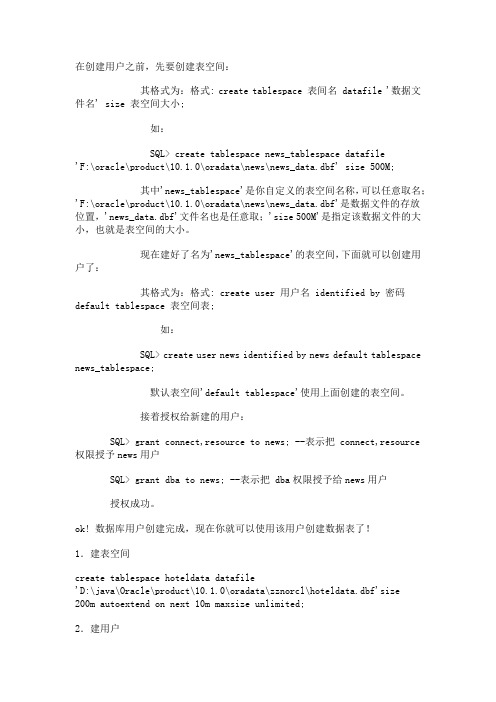
在创建用户之前,先要创建表空间:其格式为:格式: create tablespace 表间名 datafile '数据文件名' size 表空间大小;如:SQL> create tablespace news_tablespace datafile'F:\oracle\product\10.1.0\oradata\news\news_data.dbf' size 500M;其中'news_tablespace'是你自定义的表空间名称,可以任意取名;'F:\oracle\product\10.1.0\oradata\news\news_data.dbf'是数据文件的存放位置,'news_data.dbf'文件名也是任意取;'size 500M'是指定该数据文件的大小,也就是表空间的大小。
现在建好了名为'news_tablespace'的表空间,下面就可以创建用户了:其格式为:格式: create user 用户名 identified by 密码 default tablespace 表空间表;如:SQL> create user news identified by news default tablespace news_tablespace;默认表空间'default tablespace'使用上面创建的表空间。
接着授权给新建的用户:SQL> grant connect,resource to news; --表示把 connect,resource权限授予news用户SQL> grant dba to news; --表示把 dba权限授予给news用户授权成功。
ok! 数据库用户创建完成,现在你就可以使用该用户创建数据表了!1.建表空间create tablespace hoteldata datafile'D:\java\Oracle\product\10.1.0\oradata\zznorcl\hoteldata.dbf'size200m autoextend on next 10m maxsize unlimited;2.建用户create user hotel identified by hotel default tablespace hoteldata account unlock;//identified by 后面的是密码,前面的是用户名3.用户授权grant resource,connect,RECOVERY_CATALOG_OWNER to hotel ;grant create table to hotel;alter user hotel quota unlimited ON OSDB;alter user hotel default tablespace hoteldata;4.删除表空间DROP TABLESPACE hoteldata INCLUDING CONTENTS AND DATAFILES;5.删除用户DROP USER hotel CASCADE6.删除表的注意事项在删除一个表中的全部数据时,须使用TRUNCATE TABLE 表名;因为用DROP TABLE,DELETE * FROM 表名时,TABLESPACE表空间该表的占用空间并未释放,反复几次DROP,DELETE操作后,该TABLESPACE上百兆的空间就被耗光了。
java jdbc 连接oracle查询建表语句

java jdbc 连接oracle查询建表语句使用Java JDBC连接Oracle数据库并执行查询或建表语句,你需要首先确保已经安装了Oracle JDBC驱动(例如ojdbc8.jar)。
以下是一个简单的示例,展示如何连接到Oracle数据库并执行查询或建表语句。
1、导入必要的库:javaimport java.sql.Connection;import java.sql.DriverManager;import java.sql.Statement;import java.sql.ResultSet;import java.sql.SQLException;2、加载Oracle JDBC驱动:javaClass.forName("oracle.jdbc.driver.OracleDriver");3、建立数据库连接:javaString url = "jdbc:oracle:thin:@//localhost:1521/orcl"; // 根据你的数据库地址和端口进行修改String username = "your_username"; // 你的数据库用户名String password = "your_password"; // 你的数据库密码Connection connection = DriverManager.getConnection(url, username, password);4、创建Statement对象并执行查询或建表语句:javaStatement statement = connection.createStatement();String sql = "CREATE TABLE employees (id INT PRIMARY KEY, name VARCHAR(30), age INT)"; // 建表语句示例try {statement.execute(sql); // 执行建表语句System.out.println("Table created successfully");} catch (SQLException e) {e.printStackTrace();}5、执行查询语句并获取结果:javasql = "SELECT * FROM employees"; // 查询语句示例try {ResultSet resultSet = statement.executeQuery(sql); // 执行查询语句,获取结果集while (resultSet.next()) { // 遍历结果集System.out.println("ID: " + resultSet.getInt("id")); // 获取列数据,这里以id列为例System.out.println("Name: " + resultSet.getString("name")); // 获取列数据,这里以name列为例System.out.println("Age: " + resultSet.getInt("age")); // 获取列数据,这里以age列为例}} catch (SQLException e) {e.printStackTrace();} finally { // 最后,关闭连接和Statement对象以释放资源try {if (resultSet != null) resultSet.close(); if (statement != null) statement.close(); if (connection != null) connection.close(); } catch (SQLException e) {e.printStackTrace();}}。
oracle sql查看表的建表语句
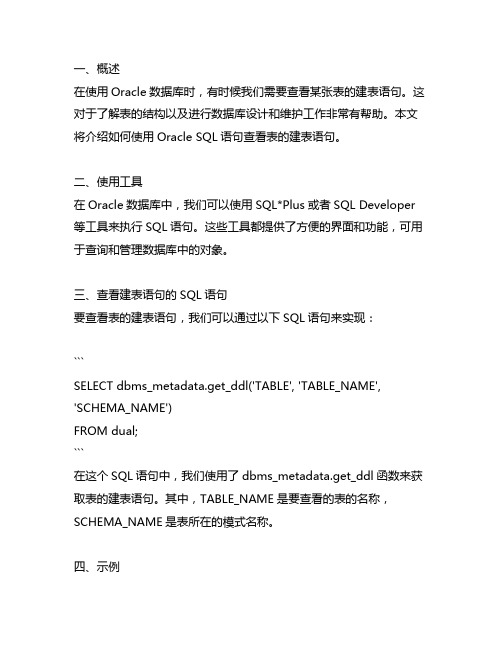
一、概述在使用Oracle数据库时,有时候我们需要查看某张表的建表语句。
这对于了解表的结构以及进行数据库设计和维护工作非常有帮助。
本文将介绍如何使用Oracle SQL语句查看表的建表语句。
二、使用工具在Oracle数据库中,我们可以使用SQL*Plus或者SQL Developer 等工具来执行SQL语句。
这些工具都提供了方便的界面和功能,可用于查询和管理数据库中的对象。
三、查看建表语句的SQL语句要查看表的建表语句,我们可以通过以下SQL语句来实现:```SELECT dbms_metadata.get_ddl('TABLE', 'TABLE_NAME','SCHEMA_NAME')FROM dual;```在这个SQL语句中,我们使用了dbms_metadata.get_ddl函数来获取表的建表语句。
其中,TABLE_NAME是要查看的表的名称,SCHEMA_NAME是表所在的模式名称。
四、示例下面通过一个示例来演示如何使用以上SQL语句来查看表的建表语句。
假设有一个名为EMPLOYEE的表,它存储了员工的基本信息。
我们可以使用以下SQL语句来查看这个表的建表语句:```SELECT dbms_metadata.get_ddl('TABLE', 'EMPLOYEE', 'HR') FROM dual;```其中,'EMPLOYEE'是表的名称,'HR'是表所在的模式名称。
五、注意事项在使用以上SQL语句时,需要注意以下几点:1. 需要有适当的权限来执行dbms_metadata.get_ddl函数。
通常情况下,只有具有DBA权限或者CREATE ANY TABLE权限的用户才能执行该函数。
2. 在执行SQL语句时,需要替换相应的表名称和模式名称。
3. 如果要查看其他类型的对象(如索引、触发器等)的建表语句,可以修改SQL语句中的参数。
oracle批量导出建表语句

oracle批量导出建表语句如果你需要将Oracle数据库中的多个表的建表语句导出到一个文件中,可以使用以下步骤:1. 登录到 Oracle 数据库中的 SQL*Plus 命令行工具。
2. 使用以下命令查询数据库中的所有表名并将结果保存到文件中:```sqlSET PAGESIZE 0SET FEEDBACK OFFSET HEADING OFFSPOOL tables.sqlSELECT 'CREATE TABLE ' || table_name || ' (' || column_name || ' ' || data_type || ' ' ||DECODE(nullable, 'N', 'NOT NULL', ' ') || ', ' || CHR(10) ||(SELECT LISTAGG(column_name || ' ' || data_type || ' ' || DECODE(nullable, 'N', 'NOT NULL', ' '), ', ' || CHR(10)) WITHIN GROUP (ORDER BY column_id)FROM all_tab_columnsWHERE table_name = t.table_name) || ');' || CHR(10) || CHR(10)FROM all_tables t, all_tab_columns cWHERE t.table_name = c.table_nameGROUP BY t.table_name, t.owner;SPOOL OFF```这个命令会查询所有表的建表语句并将结果保存到名为`tables.sql` 的文件中。
exp语句导出表结构建表语句

exp语句导出表结构建表语句
EXP是Oracle数据库中的一个工具,用于数据的导入和导出操作。
通过EXP语句,我们可以将指定的表或视图的数据和结构导出为一
个.dmp文件,然后可以使用IMP或IMPDP命令将该.dmp文件导入到另
一个数据库中。
下面是一个示例的EXP语句,用于导出一个表的结构和数据:
EXP username/password@database FILE=export.dmp
TABLES=table_name
上述语句中,username是数据库用户的名称,password是用户的
密码,database是数据库的连接信息,export.dmp是导出的文件名,table_name是要导出的表的名称。
需要注意的是,如果只想导出表结构而不导出数据,可以加上参
数ROWS=N,示例:
EXP username/password@database FILE=export.dmp
TABLES=table_name ROWS=N
在实际使用中,我们还可以通过EXP语句的其他参数来控制导出的内容,例如:
- QUERY:通过指定查询条件,只导出满足条件的数据;
- WHERE:通过指定WHERE子句,只导出满足条件的数据;
- INDEXES、GRANTS、CONSTR。
oracle通过dmp文件获取建表,建用户语句

oracle通过dmp⽂件获取建表,建⽤户语句oracle可以通过impdp命令⼯具获取建⽤户和建表的语句。
impdp指定参数sqlfile可以解析dmp⽂件。
数据导出命令⾏:[oracle@node01 ~]$ expdp \' / as sysdba\' directory=dmpdir dumpfile=expdptest.dmp schemas=test logfile=expdptest.log解析导出的dmp⽂件:[oracle@node01 ~]$ impdp \'/ as sysdba\' directory=dmpdir dumpfile=expdptest.dmp sqlfile=expdptest.sql这样就可以查看建⽤户,建表语句:[oracle@node01 ~]$ cat expdptest.sql-- CONNECT SYSALTER SESSION SET EVENTS '10150 TRACE NAME CONTEXT FOREVER, LEVEL 1';ALTER SESSION SET EVENTS '10904 TRACE NAME CONTEXT FOREVER, LEVEL 1';ALTER SESSION SET EVENTS '25475 TRACE NAME CONTEXT FOREVER, LEVEL 1';ALTER SESSION SET EVENTS '10407 TRACE NAME CONTEXT FOREVER, LEVEL 1';ALTER SESSION SET EVENTS '10851 TRACE NAME CONTEXT FOREVER, LEVEL 1';ALTER SESSION SET EVENTS '22830 TRACE NAME CONTEXT FOREVER, LEVEL 192 ';-- new object type path: SCHEMA_EXPORT/USER-- CONNECT SYSTEMCREATE USER "TEST" IDENTIFIED BY VALUES 'S:BF976574B1327B4A16FA8A5646627B09E4CB07FEAF9CCFE4F7806FB73399;48724AE7C369325F'DEFAULT TABLESPACE "TEST"TEMPORARY TABLESPACE "TEMP";-- new object type path: SCHEMA_EXPORT/SYSTEM_GRANTGRANT UNLIMITED TABLESPACE TO "TEST";-- new object type path: SCHEMA_EXPORT/ROLE_GRANTGRANT "CONNECT" TO "TEST";GRANT "RESOURCE" TO "TEST";-- new object type path: SCHEMA_EXPORT/DEFAULT_ROLEALTER USER "TEST" DEFAULT ROLE ALL;-- new object type path: SCHEMA_EXPORT/PRE_SCHEMA/PROCACT_SCHEMA-- CONNECT TESTBEGINsys.dbms_logrep_imp.instantiate_schema(schema_name=>SYS_CONTEXT('USERENV','CURRENT_SCHEMA'), export_db_name=>'ORCL', inst_scn=>'1543220'); COMMIT;END;/-- new object type path: SCHEMA_EXPORT/TABLE/TABLE-- CONNECT SYSCREATE TABLE "TEST"."TEST"( "ID" NUMBER(*,0)) SEGMENT CREATION IMMEDIATEPCTFREE 10 PCTUSED 40 INITRANS 1 MAXTRANS 255NOCOMPRESS LOGGINGSTORAGE(INITIAL 65536 NEXT 1048576 MINEXTENTS 1 MAXEXTENTS 2147483645PCTINCREASE 0 FREELISTS 1 FREELIST GROUPS 1BUFFER_POOL DEFAULT FLASH_CACHE DEFAULT CELL_FLASH_CACHE DEFAULT)TABLESPACE "TEST" ;。
create table建表语句oracle
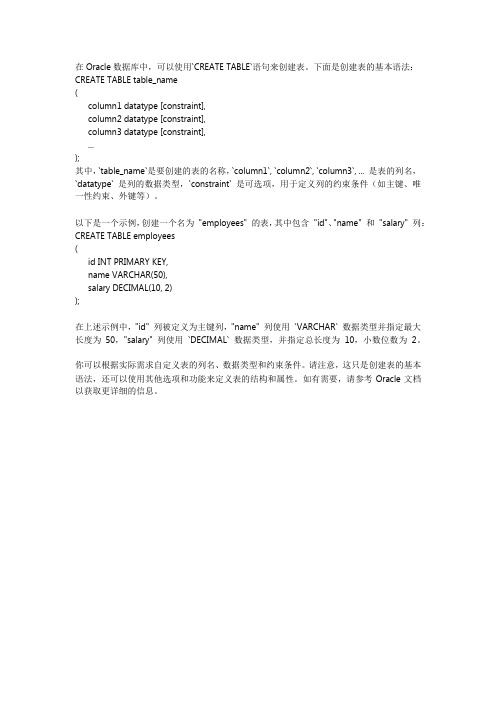
在Oracle数据库中,可以使用`CREATE TABLE`语句来创建表。
下面是创建表的基本语法:CREATE TABLE table_name
(
column1 datatype [constraint],
column2 datatype [constraint],
column3 datatype [constraint],
...
);
其中,`table_name`是要创建的表的名称,`column1`, `column2`, `column3`, ... 是表的列名,`datatype` 是列的数据类型,`constraint` 是可选项,用于定义列的约束条件(如主键、唯一性约束、外键等)。
以下是一个示例,创建一个名为"employees" 的表,其中包含"id"、"name" 和"salary" 列:CREATE TABLE employees
(
id INT PRIMARY KEY,
name VARCHAR(50),
salary DECIMAL(10, 2)
);
在上述示例中,"id" 列被定义为主键列,"name" 列使用`VARCHAR` 数据类型并指定最大长度为50,"salary" 列使用`DECIMAL` 数据类型,并指定总长度为10,小数位数为2。
你可以根据实际需求自定义表的列名、数据类型和约束条件。
请注意,这只是创建表的基本语法,还可以使用其他选项和功能来定义表的结构和属性。
如有需要,请参考Oracle文档以获取更详细的信息。
oracle获取建表语句

oracle获取建表语句
oracle数据库是一种关系型数据库管理系统,它可以帮助
用户组织、存储和管理数据,并允许用户在数据库中创建自己的表。
为了使用oracle数据库,用户必须了解如何创建表,以及如何使用oracle获取建表语句。
首先,用户需要在oracle数据库中创建表。
为此,用户可以使用Oracle的创建表语句,即CREATE TABLE语句。
这个语句用于定义表的列,每列都包含一个字段名和一个数据类型,以及一些可选的限制。
在添加表列之后,用户可以使用
ALTER TABLE语句来添加或删除表的列,或者使用DROP TABLE语句来删除表。
在创建完表之后,用户可以使用oracle的SHOW CREATE TABLE语句来获取表的建表语句。
这个语句将显示oracle创建表的完整语句,包括表的名称、列名、数据类型和
限制。
这个语句可以帮助用户了解表的结构,并可以帮助用户更改表的结构。
此外,用户还可以使用oracle的DESCRIBE语句来查看
表的结构。
这个语句将显示表的字段名、数据类型和限制,但不会显示完整的建表语句。
通过使用oracle获取建表语句,用户可以快速了解表的结构。
它可以帮助用户研究oracle数据库的基本知识,并可以帮助用户更好地管理自己的数据库。
- 1、下载文档前请自行甄别文档内容的完整性,平台不提供额外的编辑、内容补充、找答案等附加服务。
- 2、"仅部分预览"的文档,不可在线预览部分如存在完整性等问题,可反馈申请退款(可完整预览的文档不适用该条件!)。
- 3、如文档侵犯您的权益,请联系客服反馈,我们会尽快为您处理(人工客服工作时间:9:00-18:30)。
3.delete语句不影响表所占用的extent, 高水线(high watermark)保持原位置不动
显然drop语句将表所占用的空间全部释放 truncate 语句缺省情况下见空间释放到 minextents个 extent,
除非使用reuse storage; truncate会将高水线复位(回到最开始).
1:创建临时表空间
create temporary tablespace user_temp
tempfile 'Q:\oracle\product\10.2.0\oradata\Test\xyrj_temp.dbf'
size 50m
autoextend on
next 50m maxsize 20480m
temporary tablespace user_temp;
第4步:给用户授予权限
grant connect,resource,dba to username;
4. 删除操作中的truncate,delete(不带where子句的delete语句),drop异同-------转至CSDN志志的博客
extent management local;
2:创建数据表空间
create tablespace user_data
logging
datafile 'Q:\oracle\product\10.2.0\oradata\Test\xyrj_data.dbf'
size 50m
依赖于该表的存储过程/函数将保留,但是变为invalid状态.
2.delete语句是dml,这个操作会放到rollback segement中,事务提交之后才生效;
如果有相应的trigger,执行的时候将被触发. truncate,drop是ddl, 操作立即生效,
原数据不放到rollback segment中,不能回滚. 操作不触发trigger.
相同点:
truncate和不带where子句的delete, 以及drop都会删除表内的数据
不同点:
1.truncate和 delete只删除数据不删除表的结构(定义)
drop语句将删除表的结构被依赖的约束(constrain),触发器(trigger),索引(index);
autoextend on
next 50m maxsize 20480m
extent management local;
第3步:创建用户并指定表空间
create user username identified by password
default tablespace user_data
4.速度,一般来说: drop>; truncate &小心使用drop 和truncate,尤其没有备份的时候.否则哭都来不及 使用上,
想删除部分数据行用delete,注意带上where子句. 回滚段要足够大. 想删除表,
当然用drop 想保留表而将所有数据删除. 如果和事务无关,用truncate即可.
如果和事务有关,或者想触发trigger,还是用delete. 如果是整理表内部的碎片,
可以用truncate跟上reuse stroage,再重新导入/插入数据
